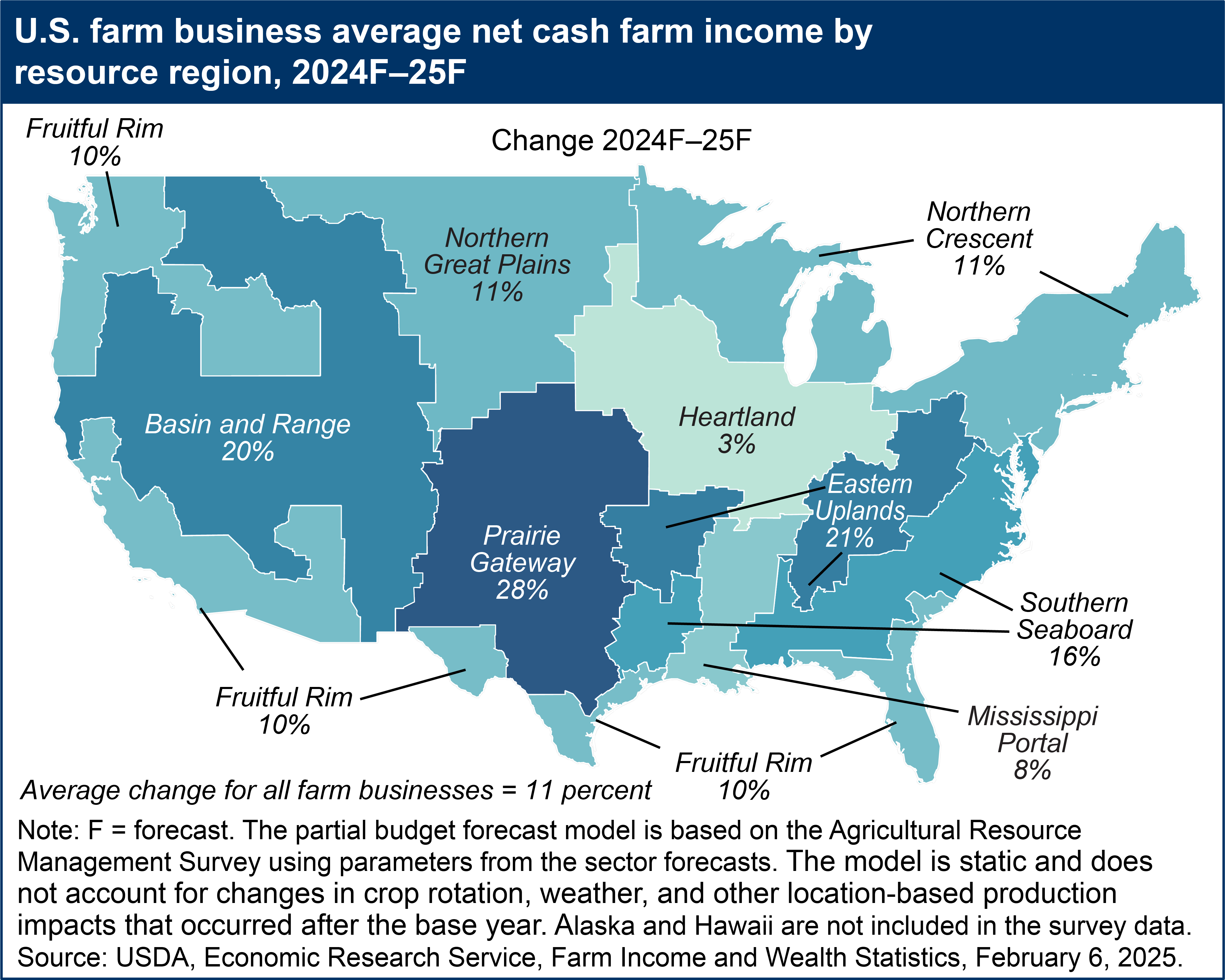Suggested citation for linking to this discussion:
U.S. Department of Agriculture, Economic Research Service. (2025, February 6). Farm sector income & finances: Farm business income.
Average Net Cash Farm Income for U.S. Farm Businesses Forecast Up in 2025
Farm businesses are farms with annual gross cash farm income (GCFI), annual income before expenses, equal to or greater than $350,000, or operations with less than $350,000 in annual gross cash farm income but that report farming as the operator's primary occupation. Farm businesses account for about half of all U.S. farms, but they contribute more than 90 percent of value of production and hold most of the sector’s assets and debt.
Average net cash farm income (NCFI) for farm businesses* is forecast at $128,900 for calendar year 2025, up 11.4 percent from 2024 in nominal terms. NCFI is cash receipts from farming as well as cash farm-related income, including Government payments, minus cash expenses. Higher NCFI could mean more cash available to pay debt, pay taxes, cover family living expenses, and invest. NCFI is not a comprehensive measure of profitability because it does not account for changes in noncash income, including adjustments in farm commodity inventories, accounts payable, accounts receivable, the imputed rental value of operator dwellings, and capital consumption.
Average NCFI is forecast to increase for 2025 for all farming regions (see the FAQ on ERS resource regions) and commodity specializations.** Following the forecast for the sector as a whole, farm businesses in all regions and commodity specializations are forecast to see higher Government payments on average in 2025. The farm business forecast uses information from the 2023 Agricultural Resource Management Survey (ARMS) to allocate the changing financial conditions reflected in the 2024 and 2025 forecasts for the farm sector across farm types and regions.
See data tables on farm business average net cash income:
- Farm-level average net cash income by farm typology and sales class
- Farm business average net cash income by commodity specialization and region
Average Net Cash Farm Income Forecast To Increase for Most Farm Businesses
In 2025, farm businesses among all crop commodity specializations except corn and soybeans are forecast to have an increase in average NCFI. Farm businesses specializing in wheat are expected to see the largest percentage increase (58.6) with average NCFI forecast at $106,600 in 2025. Farm businesses specializing in cotton are expected to see the largest dollar increase ($83,300) with average NCFI forecast at $377,600 in 2025. Farm businesses specializing in corn are expected to see a decrease of $4,700 (3.0 percent) to an average NCFI of $150,500 in 2025. Average NCFI for farm businesses specializing in soybeans is forecast to remain stable in 2025.
| Farm specialization | Average NCFI, 2025F | Change in average NCFI, 2024F–25F |
|---|---|---|
| Dollars (per farm) | Percent | |
| Cotton | 377,600 | 28 |
| Corn | 150,500 | –3 |
| Wheat | 106,600 | 59 |
| Soybeans | 66,700 | 0 |
| Specialty crops 1/ | 303,000 | 3 |
| Other crops | 76,900 | 10 |
| F = forecast. NCFI = net cash farm income. 1/ Specialty crops include fruit and tree nuts, vegetables, and nursery/greenhouse. Source: USDA, Economic Research Service, Farm Income and Wealth Statistics data product, Farm business average net cash income by commodity specialization and region. Data as of February 6, 2025. |
||
For all types of farm businesses specializing in animals/animal products, average NCFI is forecast to increase in 2025 relative to 2024. For those specializing in dairy, average NCFI is forecast to see the largest dollar ($150,200) and percentage (25.3 percent) increase among animals/animal products specializations. This increase is due in part to expected higher cash receipts and lower costs for feed in 2025.
| Farm specialization | Average NCFI, 2025F | Change in average NCFI, 2024F–25F |
|---|---|---|
| Dollars (per farm) | Percent | |
| Dairy | 743,900 | 25 |
| Hogs | 305,600 | 22 |
| Poultry | 176,800 | 15 |
| Cattle/calves | 72,300 | 21 |
| F = forecast. NCFI = net cash farm income. Source: USDA, Economic Research Service, Farm Income and Wealth Statistics data product, Farm business average net cash income by commodity specialization and region. Data as of February 6, 2025. |
||
Average Net Cash Farm Income (NCFI) for Farm Businesses Forecast To Increase Across All Regions in 2025
Regional performance of farm businesses can vary considerably because of the heavy geographic concentration of certain production specialties. However, all nine USDA, ERS Farm Resource Regions are expected to see an increase in average net cash farm income in 2025 compared with 2024. Farm businesses in the Prairie Gateway region are forecast to see the largest percent (27.6) and dollar ($28,600) increase per farm. These expected increases are largely because of higher Government payments.

*Farm businesses are defined as operations with gross cash farm income equal to or greater than $350,000 (labeled "commercial") or smaller operations where farming is reported as the operator's primary occupation (labeled "intermediate"). USDA Agricultural Resource Management Survey data for 2023 indicates that 13.9 percent of U.S. farms are commercial, and 35.7 percent are intermediate. Residence farms make up the remaining 50.4 percent of operations; these are small farms with operators whose primary occupation is something other than farming.
**Commodity specialization is determined by a farm business having at least 50 percent of the value of production from a particular commodity. Farm businesses often produce multiple commodities, so average net cash farm income statistics should not be interpreted as resulting solely from the production and sale of the commodity highlighted as the specialization.
